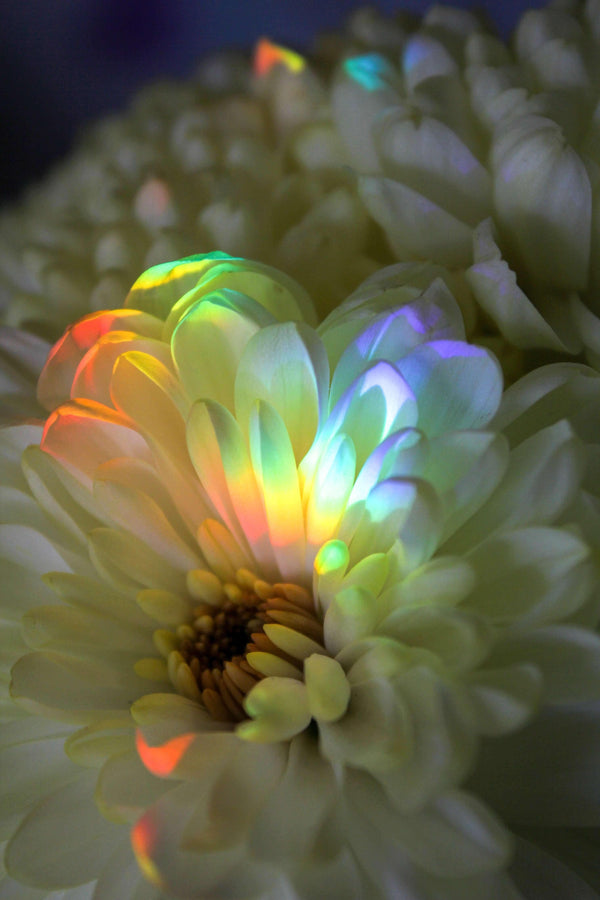An introduction to the seven Chakras
This is just a quick overview of a topic that has an abundance of information and depth and is not intended to be a comprehensive or detailed, but rather introductory. The chakras primarily represent energy. These energies are not something we can see or touch, but rather feel. There are seven of these energy systems, each of which are represented by their own color, shape, name and location in the body, beginning at the base of the spine and moving upwards above the crown of the head. As they move “up” their progression runs from basic, physical needs to the most spiritual, as their colors run from the warm tones of home, stability and roots to the cool tones of spirituality and connection with a larger universe.
- Muladhara: Red in color, Muladhara is the root chakra, located at the base of the spine. Its mantra is LAM and its element is Earth. It is directly linked to the roots we’ve planted-how deep they are, how strong they are, and how supportive they are. Often associated with home, safety, security, water, food and family, it is a foundational grounded energy. The shape itself has symbolic meaning. The square represents rigidity and provides a stable structure for the chakra system to rest on. The upside-down triangle is the alchemical symbol for earth and the grounding energy of Muladhara. The four petals represent the four mind-states that originate in this chakra: mind, intellect, consciousness and ego.
- Svadhishthana: Orange in color, Svadhishthana is the sacral chakra, located in your pelvis. Its mantra is VAM and its element is water. Water brings to mind fluidity, versatility and freedom. This energy is associated with your center of creativity, as well as intimacy, family and procreation. The shape is comprised of circles in connection with six lotus flower petals, and represents the cyclical nature of birth, death and rebirth. The circles also create a crescent moon shape reminding us of the connection between creativity and reproduction with the phases of the moon.
- Manipura: Yellow in color, Manipura is the solar plexus chakra, located just below the heart. Its mantra is RAM and its element is fire. This chakra is your power center where you find you core strength and fire. It governs our self-esteem, confidence and personal identity. Here you’ll find a sense of purpose and self-motivation, but you may also battle ego while learning to balance personal power with compassion. The shape features 10 petals representing ten pranas in your body-five pranas and five upa pranas (breaths). The upside-down triangle represents the energy of the lower three chakras being concentrated and spreading these foundational energies up to the higher chakras.
- Anahata: Green in color, Anahata is the heart chakra, located at the center of your chest. Its mantra is YUM and its element is air. This chakra represents everything that involves love, compassion, joy, forgiveness and acceptance of others. It is one of the most emotional chakras to tap into. As the central chakra, it bridges your physical power below and your spirituality and creativity above. The symbol features two triangles, upward and downward facing, intertwined yet opposing energies, to create a six pointed star. It is surrounded by 12 petals which relate numerically to energy channels.
- Vishuddha: Sky blue in color, Vishuddha is the throat chakra. Its mantra is HUM and its element is space. It is the first of the three spiritual chakras and houses your ability to communicate and speak up for what you believe in. It symbolizes an open space from where authenticity and truthfulness can flow, ideas can be expressed clearly and you can be in tune with you inner and outer intentions. It is your voice. Symbolically, the triangle opening upwards represents the gathering of knowledge towards enlightenment. The 16 petals are associated with the 16 vowels of the Sanskit language, whose pronunciation is light and breathy, like the airy quality of communication.
- Ajna: Indigo in color, Ajna is the third-eye chakra, located in the space between the eyebrows. Its mantra is SHAM and over all elements. It represents our intuition and the place form which our knowledge stems. It is how we perceive the exterior world as well as our own interior dialogue. The symbol continues the upside-down triangle, continuing to push knowledge towards enlightenment.
- Sahasrara: Violet in color, Sahasrara is the crown chakra, located just above the crown of the head. Its mantra is OM, and its element is cosmic energy. It represents our spiritual selves and an interconnectedness beyond your physical experience. It can represent a divine unity with other beings and with the universe. The circle and lotus flower are a reminder of creation, unity, prosperity and eternity.
Further exploration of how these energy systems impact our interactions in the world, as well as our moods, behaviors and mental and physical well being will give more practical meaning these concepts. The concept of "balance" in our energies will also be presented in additional blogs.

The symbols of yoga are not meant to be exclusionary or overly shrouded in mystery. Yoga never requires you to do or think anything that is contrary to your foundational beliefs. Many of its tenants are universally shared by other belief systems, such as the communion of people and the need for and gratitude towards a higher power. Everyone is welcome to join in yoga meditation and practice which celebrate with gratitude the joining together of the mind and body.
At My Yoga Essentials, we have a wide variety of products that can help serve as a reminder to be present and aware of these vital energy centers. You can find reminders of the chakras in anything from a bracelet you glance to on your wrist, the mat you practice on, the shirts or workout clothes you wear, or a piece of art on your wall. We have a 100% satisfaction guarantee, so you can be confident shopping with us.
If you've enjoyed this post, or have ideas for future blogs, we'd love to hear from you! Send us your thoughts, or better yet, become a guest blogger. Submit your ideas and we'll get back to you with guest blogger requirements.


